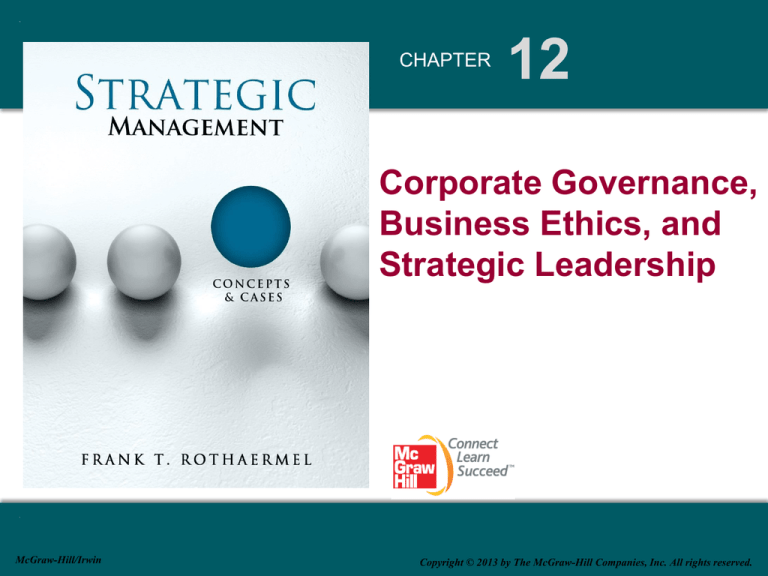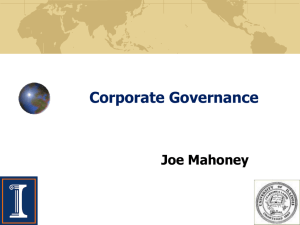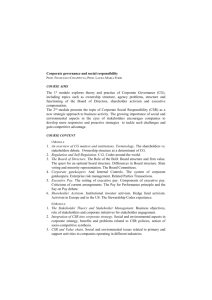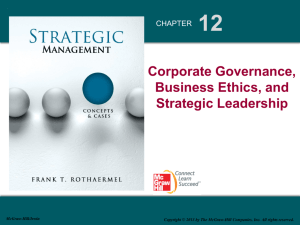
CHAPTER
12
Corporate Governance,
Business Ethics, and
Strategic Leadership
McGraw-Hill/Irwin
Copyright © 2013 by The McGraw-Hill Companies, Inc. All rights reserved.
Part 3 Strategy Implementation
LO 12-1 Describe and evaluate the relationship between
strategic management and the role of business in
society.
LO 12-2 Conduct a stakeholder impact analysis.
LO 12-3 Critically evaluate the relationship between corporate
social performance (CSR) and competitive advantage.
LO 12-4 Describe the role of corporate governance and evaluate
different governance mechanisms.
LO 12-5 Describe and evaluate the relationship between business
strategy and ethics.
LO 12-6 Describe the different roles that strategic leaders play
and how to become a strategic leader.
ChapterCase 12
HP’s CEO Mark Hurd Resigns
amid Ethics Scandal
• Mark Hurd
CEO of HP after Carly Fiorina
Low profile, no-nonsense, strategy execution forte
• Highly successful
Increasing market shares for computers and printers
Stock rose 110% (well above that of NASDAQ)
• 2010 sexual harassment scandal
Forced to resign
With $45 million severance package
Hired by Oracle
Strategic Management and the
Role of Business in Society
• The public stock company is the backbone of
our economy.
• Four characteristics of public firms:
Limited liability for investors
Transferability of investor interest
Legal personality
Separation of ownership and control
EXHIBIT 12.1
The Public Stock Company: Hierarchy of Authority
Strategic Management and the
Role of Business in Society
• 21st century already two financial crises
Accounting scandals: Enron, WorldCom, Tyco…
Global financial crisis: real estate bubble burst
• Lessons
Managerial actions affect economy
Ethical business produces wealth but unethical practices destroy it
Stakeholder management is needed
EXHIBIT 12.2
Honesty and Ethics Ranking of Different Professions
“How would you rate the honesty and ethical standards
of people in different fields?”
EXHIBIT 12.3
Stakeholder Impact Analysis
EXHIBIT 12.4
The Pyramid of Corporate Social Responsibility
LO 12-1 Describe and evaluate the relationship between strategic
management and the role of business in society.
LO 12-2 Conduct a stakeholder impact analysis.
LO 12-3 Critically evaluate the relationship between corporate social
performance (CSR) and competitive advantage.
LO 12-4 Describe the role of corporate governance and evaluate
different governance mechanisms.
LO 12-5 Describe and evaluate the relationship between business strategy
and ethics.
LO 12-6 Describe the different roles that strategic leaders play and how to
become a strategic leader.
Corporate Social Responsibility
• Milton Friedman circa 1962:
“the only social responsibility of business is
… to increase profits so long as it stays within
the rules of the game”
• Today’s businesses tend to do more than just
make profits
But does CSR help build competitive advantage?
The answer might depend on where you do
business…
UAE,
Japan, and India are less interested in CSR
China,
Brazil, and Germany are more interested in CSR
EXHIBIT 12.5
Global Survey of Attitudes toward Business
At least somewhat agree that…
“the social responsibility of business is increasing profits”
Corporate Social Responsibility
• Shared value-creation framework
Expand customer base and bring in non-consumers
Expand internal firm value chains by including more
non-traditional partners such as NGOs
Focus on creating new regional clusters
•
GE recognizes a convergence between
shareholders and stakeholders
•
Empirical evidence supports that…
“firms can do well ($) by doing good (CSR)”
Corporate Governance
• Corporate governance represents the
relationship among stakeholders that is used to
determine and control the strategic direction and
performance of organizations.
• Agency costs are the sum of incentive costs,
monitoring costs, enforcement costs, and
individual financial losses incurred by principals
because it is impossible to use governance
mechanisms to guarantee total compliance by
the agent.
Corporate Governance
• Corporate governance
Mechanisms to direct and control a firm
Ensure the pursuit of strategic goal
Address the principal–agent problem
• When corporate governance failed
Accounting scandal
Global financial crisis
Bernard Madoff Ponzi scheme
• Information asymmetry
Insider information ImClone and Galleon Group
Corporate Governance
• Agency theory
Views a firm as a nexus of legal contracts
Relationships among shareholders, managers, and hierarchies
Firms need to design work tasks
• Adverse selection
Misrepresentation of a job
Beyond his/her ability to do things
• Moral hazard
Difficulty to ascertain whether the
agent gives his/her best
Agency Problems
• Berle and Means in The Modern Corporation
inquired whether we have “any justification
assuming that those in control of a modern
corporation will also choose to operate it in the
interests of the stockholders?” (1932: p. 121)
• What are the “institutions of capitalism” which
lessen the problem of the separation of (shareholder) ownership (the risk-bearing principals)
from control (managerial decision-making
agents)?
for
Agency Problems
• What are the “institutions of capitalism” that lessen the
problem of the separation of ownership from control?
1.
2.
3.
4.
5.
Takeovers (the market for corporate control);
Recruitment of executives from outside the firm;
Monitoring by boards of directors;
Compensation heavily weighted toward stock options;
Monitoring by institutional investors;
6. Debt (minimize free cash flow; e.g., LBOs);
7. Separate Chairperson and CEO; and
8. Internal control of Multidivisional
--- “miniature capital market”
Board of Directors
• Centerpiece of corporate governance
Inside and outside directors
General strategic oversight and guidance
Selecting, evaluating, and compensating the CEO
Overseeing CEO succession plan
– Recently problematic at both HP and Apple
Providing guidance on executives and their compensation
Reviewing, monitoring, and approving strategic initiatives
Conducting a risk assessment and mitigation
Ensuring a firm’s audited financial statements
Ensuring a firm’s compliance with laws and regulations
STRATEGY HIGHLIGHT 12.1
GE’s Board of Directors
• Diversity of GE’s board of directors (17 members)
Business, academia, politicians
4 women, 2 ethnic minorities
15 board members are independent outside directors
Less likely to fall victim to groupthink
Organized into committees to function
• The separation of CEO/Board Chair duality
Due to recent global financial crisis
1–21
Other Governance Mechanisms
• Executive compensation
Stock options
Performance-oriented compensation in recent years
• The market for corporate control
External governance mechanism
Hostile takeover
Corporate raiders and hedge funds
• Auditors, government regulators, and industry
analysts
Wall Street Journal, Bloomberg Businessweek, Forbes…
Credit rating agencies
CEO Compensation
Dan Ariely Video
Corporate Governance Around the World
• Difference in national institutions and culture
• “Free” market economies?
State-directed capitalism (less freedom). Ex: China
Free market capitalism (more freedom). Ex: U.S.
• Germany
Stakeholder capitalism
Kurzarbeit
• France
Stakeholder capitalism
• China
State-owned enterprises
LO 12-1 Describe and evaluate the relationship between strategic
management and the role of business in society.
LO 12-2 Conduct a stakeholder impact analysis.
LO 12-3 Critically evaluate the relationship between corporate social
performance (CSR) and competitive advantage.
LO 12-4 Describe the role of corporate governance and evaluate
different governance mechanisms.
LO 12-5 Describe and evaluate the relationship between business
strategy and ethics.
LO 12-6 Describe the different roles that strategic leaders play and
how to become a strategic leader.
EXHIBIT 12.7
Roles that Strategic Leaders Play
EXHIBIT 12.8 Strategic Leaders: The Level 5 Pyramid
Take-Away Concepts
LO 12-1 Describe and critically evaluate the relationship between
strategic management and the role of business in society.
The public stock company is the institutional backbone of any
modern free-market economy.
Four characteristics of the public stock company make it an
attractive corporate form: limited liability for investors,
transferability of investor interests (the trading of stocks), legal
personality, and separation of ownership and control.
In the first decade of the 21st century, accounting scandals and
the global financial crises eroded the public’s trust in business as
an institution and free-market capitalism as an economic system.
Effective stakeholder management is necessary to ensure the
continued survival of the firm and to sustain any competitive
advantage .
Take-Away Concepts
LO 12-2 Conduct a stakeholder impact analysis.
Stakeholder impact analysis considers the needs of different
stakeholders, which enables the firm to perform optimally and to live up
to good citizenship.
In a stakeholder impact analysis, managers pay particular attention to
three important stakeholder attributes: power, legitimacy, and urgency.
Stakeholder impact analysis is a five-step process that answers the
following questions:
1. Who are our stakeholders?
2. What are our stakeholders’ interests and claims?
3. What opportunities and threats do our stakeholders present?
4. What economic, legal, and ethical responsibilities do we have
to our stakeholders?
5. What should we do to effectively address the stakeholder
concerns?
Take-Away Concepts
LO 12-3 Critically evaluate the relationship between corporate social
responsibility (CSR) and competitive advantage.
A majority of empirical research studies support the notion that
firms can do well (financially) by doing good (through CSR).
Some studies, however, found that the relationship is reversed:
Superior financial performance allows firms to engage in CSR
( to buy good will).
Although there seems to be a positive relationship between CSR
and firm financial performance, it is not entirely clear what
causes what.
LO 12-4 Describe the role of corporate governance and evaluate
different governance mechanisms.
Corporate governance is about checks and balances, about
asking the tough questions at the right time.
Corporate governance attempts to address the principal–agent
problem, which describes any situation in which an agent
performs activities on behalf of a principal.
Take-Away Concepts
LO 12-4 Describe the role of corporate governance and evaluate
different governance mechanisms.
The principal–agent problem is a core tenet in agency theory,
which views the firm as a nexus of legal contracts.
The principal—agent problem concerns not only the relationship
between owners (shareholders) and managers, but also
cascades down the organizational hierarchy.
The risk of opportunism on behalf of agents is exacerbated by
information asymmetry: Agents are generally better informed
than the principals.
The board of directors is the centerpiece of corporate
governance.
Other important corporate mechanisms are: executive
compensation, the market for corporate control, and financial
statement auditors, government regulators, and industry analysis.
Take-Away Concepts
LO 12-5 Describe and evaluate the relationship between business
strategy and ethics.
The ethical pursuit of competitive advantage lays the foundation
for long-term superior performance.
Law and ethics are not synonymous; obeying the law is the
minimum that society expects of a corporation and its managers.
A manager’s actions can be completely legal, but ethically
questionable.
The following questions can help managers make sound ethical
decisions.
1. Does the intended course of action fall within the acceptable
norms of professional behavior?
2. Would the manager feel comfortable explaining and defending
the decision in public?
3. How would the media report the particular business decision if it
became public?
4. How would the company’s stakeholders feel about it?
Take-Away Concepts
LO 12-6 Describe the different roles that strategic leaders play and how
to become a strategic leader.
Strategic leaders play three different roles: interpersonal,
informational, and decisional.
To become an effective strategic leader, a manager needs to
develop a set of skills to move sequentially through five different
leadership levels.
At Level 5, the executive is able to build enduring greatness for
the company through a combination of will power and humility. At
that level, ambition is primarily for the organization, rather than
for the self.







